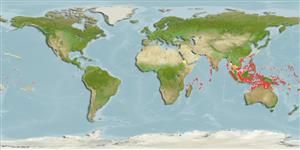>
Gobiiformes (Gobies) >
Gobiidae (Gobies) > Gobiinae
Etymology: Trimma: Greek, trimma, -atos = something crushed (Ref. 45335); tevegae: Named for the American research vessel 'Te Vega', a converted luxury yacht, operated at the
time the type specimens were collected in 1965 by Stanford University's Hopkins Marine Station..
More on authors: Cohen & Davis.
Environment: milieu / climate zone / depth range / distribution range
Ökologie
seewasser riff-verbunden, usually 10 - 40 m (Ref. 27115). Tropical; 22°C - 26°C (Ref. 27115); 33°N - 18°S
Western Pacific: from north-east Borneo and the northern Philippines southward to the Solomon Islands; apparently absent from Australian, Palauan and Japanese waters, but probably more widely distributed in Indonesia than currently documented.
Size / Gewicht / Alter
Maturity: Lm ? range ? - ? cm
Max length : 4.5 cm TL Männchen/unbestimmt; (Ref. 9710)
Rückenflossenstacheln (insgesamt): 7; Rückenflossenweichstrahlen (insgesamt): 8-9; Afterflossenstacheln 1; Afterflossenweichstrahlen: 8 - 9. Characterized by golden brown body color; white on lower head and ventral body; presence of lavender or bluish lateral stripe from upper eye to middle of caudal peduncle; caudal fin base with large dark blotch; elongate and filamentous second dorsal spine; all pectoral rays unbranched; fifth pelvic ray unbranched; longitudinal scale series 25-26; predorsal scales about 12; cheek and opercle without scales; depth of body about 4.0-4.4 in SL (Ref. 90102).
Inhabits coastal to outer reefs, typically in small groups in caves (Ref. 48637). Forms loose aggregations associated with shallow pockets and caves of steep drop-offs. Hovers in a head-up position (often vertical, posture in the water column) and feeds on copepods (Ref. 1602, 58123).
Life cycle and mating behavior
Geschlechtsreife | Fortpflanzung | Ablaichen | Eier | Fecundity | Larven
Winterbottom, R., 2016. Trimma tevegae and T. caudomaculatum revisited and redescribed (Acanthopterygii, Gobiidae), with descriptions of three new similar species from the western Pacific. Zootaxa 4144(1):001-053. (Ref. 109919)
IUCN Rote Liste Status (Ref. 130435)
Bedrohung für Menschen
Harmless
Nutzung durch Menschen
Aquarium: Kommerziell
Mehr Information
NamenSynonymeMetabolismusRäuberÖkotoxikologieFortpflanzungGeschlechtsreifeAblaichenSpawning aggregationFecundityEierEientwicklung
ReferenzenAquakulturAquakultur ProfilZuchtlinienGenetikElectrophoresesVererbbarkeitKrankheitenVerarbeitungNutrientsMass conversion
Tools
Zusatzinformationen
Download XML
Internet Quellen
Estimates based on models
Preferred temperature (Ref.
123201): 26.2 - 28.9, mean 27.9 °C (based on 464 cells).
Phylogenetic diversity index (Ref.
82804): PD
50 = 0.5000 [Uniqueness, from 0.5 = low to 2.0 = high].
Bayesian length-weight: a=0.01023 (0.00477 - 0.02194), b=3.02 (2.84 - 3.20), in cm total length, based on LWR estimates for this (Sub)family-body shape (Ref.
93245).
Trophic level (Ref.
69278): 3.0 ±0.00 se; based on food items.
Widerstandsfähigkeit (Ref.
120179): hoch, Verdopplung der Population dauert weniger als 15 Monate. (Preliminary K or Fecundity.).
Fishing Vulnerability (Ref.
59153): Low vulnerability (10 of 100).
Nutrients (Ref.
124155): Calcium = 228 [114, 540] mg/100g; Iron = 1.24 [0.61, 2.36] mg/100g; Protein = 18.2 [16.2, 19.9] %; Omega3 = 0.169 [0.071, 0.347] g/100g; Selenium = 28.4 [12.8, 61.8] μg/100g; VitaminA = 120 [32, 419] μg/100g; Zinc = 2.96 [1.85, 4.49] mg/100g (wet weight);
